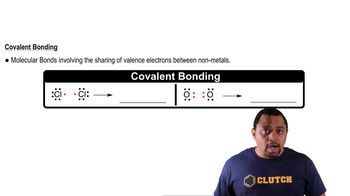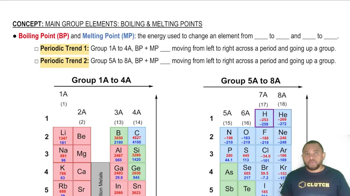The electronic structure of a doped semiconductor is shown here. (c) Which region of the diagram represents the band gap?
Covalent bonding occurs in both molecular and covalent-network solids. Which of the following statements best explains why these two kinds of solids differ so greatly in their hardness and melting points? (a) The molecules in molecular solids have stronger covalent bonding than covalent-network solids do. (b) The molecules in molecular solids are held together by weak intermolecular interactions. (c) The atoms in covalent-network solids are more polarizable than those in molecular solids. (d) Molecular solids are denser than covalent-network solids.
 Verified step by step guidance
Verified step by step guidanceKey Concepts
Covalent Bonding

Intermolecular Forces

Hardness and Melting Points

Shown here are cartoons of two different polymers. Which one would have the higher melting point?
The accompanying image shows photoluminescence from four different samples of CdTe nanocrystals, each embedded in a polymer matrix. The photoluminescence occurs because the samples are being irradiated by a UV light source. The nanocrystals in each vial have different average sizes. The sizes are 4.0, 3.5, 3.2, and 2.8 nm. (a) Which vial contains the 4.0-nm nanocrystals?
Silicon is the fundamental component of integrated circuits. Si has the same structure as diamond. (a) Is Si a molecular, metallic, ionic, or covalent-network solid?
Silicon is the fundamental component of integrated circuits. Si has the same structure as diamond. (b) Silicon readily reacts to form silicon dioxide, SiO2, which is quite hard and is insoluble in water. Is SiO2 most likely a molecular, metallic, ionic, or covalent-network solid?
What kinds of attractive forces exist between particles (atoms, molecules, or ions) in (a) molecular crystals?
